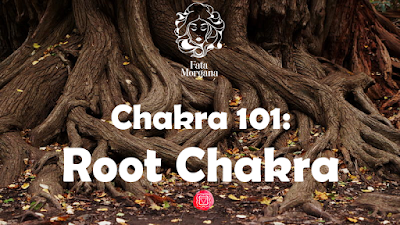You will hear people referring to chakras in popular culture, in conversations, and in spiritual practice - but do you know what Chakras are and how to work with them? It all sounds like a bunch of jargon at times, I know. So, this is where I shall attempt to drift away from the proverbial mumbo jumbo, and explain it in as simple a way as possible.
The Root Chakra
Sanskrit: Muladhara (मूलाधार, Mūlādhāra
Meaning: "root and basis of Existence."
Etymology: Mula means root and adhara means basis.
Number: 1 of 7 Primary chakras.
Origins: Hindu tantrism.
Symbol: A lotus flower with four red petals and a yellow square in the centre. On each petal, there sometimes are Sanskrit letters - va, scha, sha and sa. In the center, there would be the syllable lam - which is the Mantra of this Chakra.
Colours: Red or Pink.
Muladhara is located near the Tailbone beneath the sacrum - which is a large, triangular bone at the base of the spine that forms by the fusing of sacral vertebrae S1–S5.
The Root Chakra's kshetram, or superficial activation point, is located between the perineum and the tailbone/pelvic bone.
Because of its location and connection with the act of pooping, it is associated with the butthole.
It is also believed that Muladhara is a subtle abode of the Hindu God Ganapati.
The Root Chakra's Function
The Root Chakra keeps us grounded and roots us to familial beliefs that support the early formations of identity and a sense of belonging. It is all about family dynamics, and basic needs like feeling safe, supported, and provided for.
One might say that the Root Chakra is the centre for all of our primal needs. The main focus of this chakra is food, sex, shelter, and survival. Given that Humans are Pack Animals, this chakra also encompasses loyalty and honor to the “pack.”
The Muladhara is gorgeously primordial with earthly feminine power. It is the power of touch during love-making, or the loving affection in the form of hugs and kisses we give to our children.
The Root Chakra is the foundation of life and it urges us to procreate and express physical and supportive love to those we cherish.
How to Activate the Root Chakra
Activating and Healing the Root Chakra are two sides of the same coin. There are various ways to focus on your Root Chakra in order to heal it, balance it, and ultimately, activate it.
If you're into Yoga, the Yoga Poses for the Root Chakra include the Warrior One, Triangle Pose, and Eagle Pose.
The crystals portrayed above serve many purposes, but I figured I'd highlight their most relative properties within a Root Chakra workings context -
Black Onyx - Grounding, Protection, Dispelling Negativity
Bloodstone - Grounding, Motivation
Brecciated Jasper - Creativity, Uplifting, Calming
Carnelian - Drive, Determination, Organisation
Garnet - Passion, Creativity, Inner Strength
Golden Tiger's Eye - Courage, Determination, Relentlessness
Hematite - Grounding, Attract positivity, Stability
Kalahari Desert Jasper - Positivity, Joy, Grounding
Kyanite - Ancestral Healing, Self Acceptance, Grounding
Lava Stone - Renewal, Self growth, Positivity
Leopard skin Jasper - Courage, Self Acceptance, Motivation
Mookaite Jasper - Self Realisation, Energising, Motivation
Red Jasper - Determination, Self Love, Centering
Red Tiger's Eye - Determination, Centering, Relentlessness
Rhodonite - Balance, Self Awareness, Growth
Smoky Quartz - Dispelling negativity, Clarity, Uplifting
Snowflake Obsidian - Grounding, Protection, Balance
Tourmaline - Grounding, Protection, Dispelling Negativity
Essential Oils are another good tool to use for Root Chakra work. All of the above oils are fit for purpose. I know that they all seem to be a big jumble, so I've created a handy guide for the oils, indicating both the Aroma family they belong to, as well as what Note they are. If you're confused by the mention of Aroma and Notes, check out the previous blog post where I explained these in quite a lot of detail. You can find it
here.
Remember to always dilute an Essential Oil using a Carrier Oil if you intend to apply it topically.
If oils aren't your thing, Incense is a great alternative. Incense comes in a variety of formats. Resin incense is quite possibly my personal favourite when it comes to Chakra work. It can be used in a couple of different ways - which I had covered
in this previous post.
If you're more of an Incense Stick kind of person, there is also a selection of such incense you might want to use when working on the Root Chakra, such as the below:
Else, if you're like me and are somewhat clumsy, which means you too have a few incense stick burn marks in your sleeves and/or on your arms, Incense Cones might be better suited - such as the below:
Oh, and if you're wondering what the Red tubes featured in both Incense Sticks and Incense Cones photos are - they are Strawberry Scented incense that come with their own little incense holder, on which the Root Chakra symbol is featured. Also - the reason I included Nag Champa is that, it is a Sandalwood based blend.
And on that note, it is time to bring this post to an end. If you're too antsy to wait for the next Chakra 101 post, and want to read more about the topic, I would highly recommend the Chakra Bible, as displayed above. It is a treasure trove of a book!
Until next time!
Ros













No comments:
Post a Comment